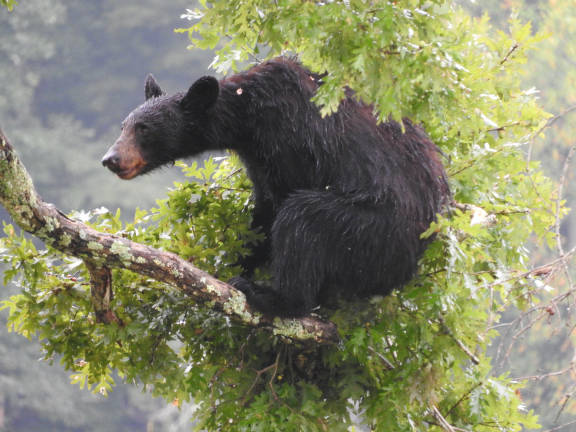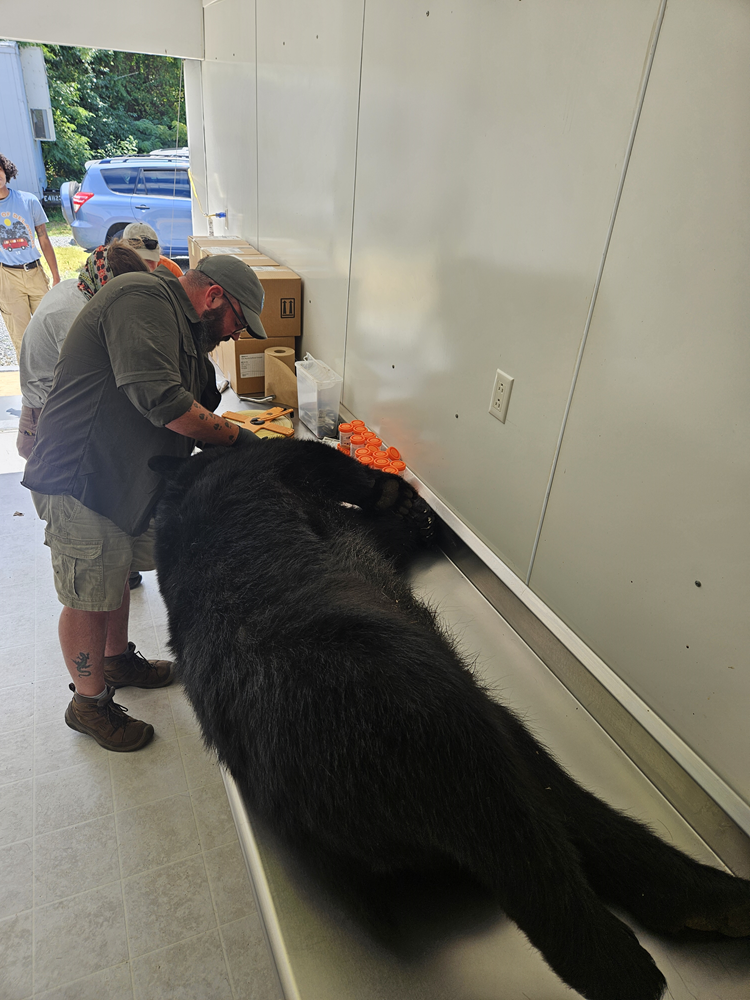Outdoor Delaware is the award-winning online magazine of the Delaware Department of Natural Resources and Environmental Control. Articles and multimedia content are produced by the DNREC Office of Communications.
American black bears once ranged throughout nearly the entirety of what is now the United States, but over the past century or two, their habitat has shrunk as the human population has spread. Today, bears are largely absent in large swathes of the country, including most of the East Coast.
In fact, prior to 2016, the last bear sighting in the First State came around 1900, in the Great Cypress Swamp in Sussex County. However, in the past eight years, Delaware has seen four black bears venture over its borders — a trend experts believe could continue.
There is nothing inherent about Delaware that makes it a bad location for a bear in terms of suitable habitat. Rather, black bears — the only bear species found in North America east of the Rocky Mountains — were hunted during colonial times until they were largely restricted to areas with few human settlements like the Appalachian Mountains.
But since then, the populations have increased and the range where bears can be found is growing.

Every year in spring and summer, young male bears disperse from the areas where they grew up in search of proverbial greener pastures, according to experts with the Delaware Department of Natural Resources and Environmental Control.
“That’s the survival genetic mixing strategy of black bears, so these males will move off and find their own territories,” said Joe Rogerson, an environmental program manager in the DNREC Division of Fish and Wildlife who oversees the Species Conservation and Research Program. “I think what we’re seeing is that as these ranges expand in our surrounding states, that’s putting areas where black bears occupy closer to Delaware’s border, which in turn increases the chances that they’ll walk far enough and enter into our state.”
Over the past eight years, four bears have ventured into northern Delaware. Rogerson attributes this activity to expanding bear populations in surrounding states, bringing bears closer to Delaware’s border. It is an inevitable outcome of an expanding population moving east through Maryland and south through Pennsylvania and New Jersey.
Cecil County, Maryland, is one of the most rural areas between the Washington-New York corridor, making it natural that some bears would find their way there and then wander over into New Castle County. After all, it’s not like they are going to swim across the Chesapeake Bay to get to Delaware.
“Unfortunately for Delaware’s sake, where they enter our state is our most densely populated area from a human perspective and really the least preferred place we would ever want to have bears,” Rogerson said.
Each of the four bears that traveled to the First State caused a frenzy of sorts, with local media breathlessly reporting on the bears’ whereabouts and residents posting on social media about potential sightings.
Some people have proactively gone looking for the bears in hopes of observing wildlife up close.
This, Rogerson emphasized, is a bad idea. Bears are still wild animals that could harm humans if pressured, and having hordes of people swarming areas with reported bear sightings makes it more difficult for DNREC biologists and law enforcement to do their jobs.

Black bears are not particularly aggressive and in fact can be scared away by loud noises. Anyone who spots a bear should give it plenty of space, and if a bear has been seen nearby, residents are urged not to leave pets unattended outside.
Individuals who encounter a black bear in the woods should remain calm and slowly back away. Do not run, as that could cause the bear to give chase. Frequent hikers can also carry bear spray as a precaution.
Black bears typically weigh between 100 and 500 pounds, with male bears being larger than female bears. They can run up to 35 miles an hour and climb a 100-foot tree in half a minute.
The species breeds during the summer and hibernates in winter. It is most active at dusk and dawn. Each bear typically has a range of a few dozen to a few hundred square miles, which may overlap with other bears’ ranges. Black bears are omnivorous, dining on berries, nuts, insects, birds, reptiles and mammals.
Despite the name, black bears can also be different shades of brown.
After the first black bear was spotted in 2016, DNREC began working with neighboring states to develop a response plan and joined BearWise, a program made up of fish and wildlife agencies from the United States and Canada, as well as related nonprofits.
The agency has learned a lot since the first sighting, Rogerson said, including how the public can be better prepared when bears arrive. In addition to giving the animals their space and not harassing them, homeowners can take some steps to minimize conflicts and reduce the appeal of areas around their homes to bears. When a bear arrives, homeowners should remove potential food sources, which could encourage it to be closer to houses than residents would prefer. Bird feeders should be temporarily removed, food left outside for pets should be taken in and trash cans should be properly stored.
“We really encourage people to review the resources on the BearWise website as these were developed by experts from across the country. We’re grateful to have this information available to help our communities become more informed on how to respond and behave when a bear is in the area,” said Rogerson.
In 2016, the bear eventually meandered out of Delaware. Confirmed bear sightings later occurred in 2019 and 2020, prompting the nickname “Delabear.” Both of those bears spent a relatively short time in the state before leaving, though one of them gave DNREC headaches when it traveled down the Brandywine Creek close to downtown Wilmington.
Unfortunately, in 2024, things went a little differently. After receiving reports on June 23 about a bear sighting the day before, DNREC began tracking this year’s bear.
The bear remained in place during the day, traveling at night when the heat was less of an issue. One night, it went about five miles as the crow flies.
The night of June 25, the bear was hit and killed by a car on Del. Route 1 near New Castle. DNREC is currently conducting tests on the creature to try to determine its age and where it originated from.
“The samples taken from the bear during its necropsy have been sent off to the lab, and it will take some time before an age and population origin from its genetics can be determined,” Sam Millman, a wildlife biologist with the Division of Fish and Wildlife, said.

As a sign of how much the bear enthralled Delaware, the state House of Representatives even passed a resolution recognizing it “quickly won the hearts and minds of Delawareans” and mourning its passing.
While the bear was still alive, DNREC closely monitored it and was prepared to set up the trap if the beast seemed to stay in one spot. However, because of its mobility, the agency was unable to do so.
“He never settled down at a point where we could deploy the trap because every night we didn’t know which direction he was going to walk,” Rogerson said. “We didn’t know how far he was going to walk. It literally would have been putting a needle in a haystack hoping this bear would find a trap with some donuts and we catch it.”
Delaware Natural Resources Police officers were prepared to utilize deadly force if the bear became hostile, such as attacking pets, but the situation never came to that.
While some may be wondering why DNREC did not just send personnel out to shoot the bear with a tranquilizer and then physically transport it, Rogerson explained that is much more difficult than it sounds.
For starters, the tranquilizer guns have a very limited range. Additionally, the drug takes a few minutes to kick in, during which time the panicked bear could cause property damage or even attack humans it comes across. Putting it to sleep temporarily would also make it more difficult for the creature to regulate its body temperature, posing a risk of the bear overheating.
Should the need arise, DNREC is prepared to transport any visiting bears to a more rural area, although doing so would require permission from whatever state they would be moved to.
“The ideal situation is the bear shows up and realizes there aren’t any other bears here and goes back across the border to another state, and then it’s not our problem anymore,” Rogerson said with a laugh.
Though the agency did not capture any of the past visitors, Rogerson is confident each one was indeed a different bear, as it’s the juvenile male bears (think the bear equivalent of teenage boys) that tend to wander.
Going forward, it is likely bears will continue to visit the state on occasion. Bears in Connecticut and Massachusetts live in more densely populated areas, Rogerson said, meaning Delaware’s relatively high level of urbanization is not an obstacle that would prevent the species from settling down here. Rather, Delawareans’ unfamiliarity with living with bears means DNREC strives to keep them from becoming permanent residents.
Ultimately, there’s much more suitable habitat just 100 miles or so to the north and west.
“While Delaware could support bears from a food resource perspective, the developed landscape that we have and the movements of bears is really not conducive to their wellbeing here,” Rogerson said. “There’s a lot of perils and challenges with the number of roads we have.”
Related Topics: animals, bears, black bears, fish and wildlife, natural resources police, nature, outdoor delaware